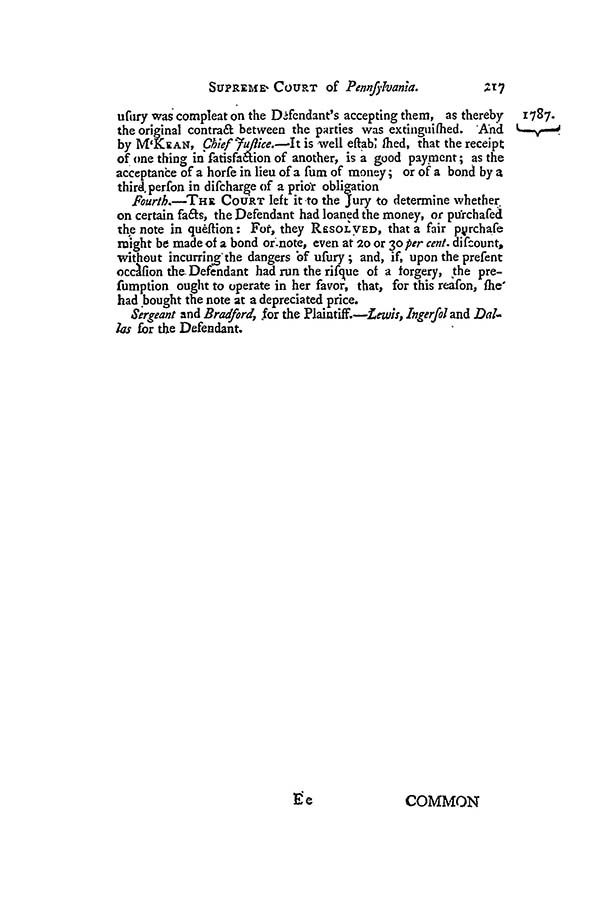Musgrove v. Gibbs, 1 Dall. 216 (Pa. 1787)
Supreme Court of Pennsylvania:
September Term, 1787
Musgrove, Qui tam &c. versus Gibbs
This was an action qui tam &c. on the Act of Assembly against Usury; and, in the course of the trial, the Court resolved the following points:
First.—Richardson, through the mediation of Shoemaker, borrowed 800 Dollars of the Defendant, and gave his note for 840 Dollars payable in one month. There was no talk about premium at the time of the loan; but it was understood by the witnesses, that the Borrower was to pay at the rate of 5 per cent.'per month for the money. At the end of the month, Richardson paid L.168. on account of his note, and gave a new note, drawn in favor of, and indorsed by, Shoemaker, for the ballance. He discharged the amount of this last note at different times; but it was never given up by the Defendant.
Resolved, that this was an illegal loaning of money, not the purchase of a note, so as to avoid the penalties of the act; and that the usury was compleat on taking and receiving the L.168; as a proportion of that sum, went towards payment of the illegal interest included in the original note.
Second.—The usurious contract was stated in several Counts of the declaration, to be with Shoemaker and Shirtliffe (who were Partners) jointly; but the proof was of a note given by Shoemaker alone.
Resolved, that this variance is fatal: For, an action upon the note could only be maintained against Shoemaker, who, if he intended to bind his partner, ought to have used the firm of the company; and, besides, if there should be a recovery against the Defendant on the present count, it would be no bar to another qui tam action on the same note, stating the usurious contract to have been with Shoemaker alone.
Third.—Shoemaker and Shirtliffe borrowed several sums from the Defendant, and gave their notes payable in a month, with interest, at the rate of 5 per cent. per month, added to the principal. When these became due, they could not pay the money, but drew new notes, making the principal and interest of the former notes (which were given up by the Defendant) principal, and again adding the same excessive interest upon the agregate amount.
Resolved, that, although no money was actually paid to the Defendant, the second notes were a satisfaction of the first; and the
Fourth.—The Court left it to the Jury to determine whether on certain facts, the Defendant had loaned the money, or purchased the note in question: For, they Resolved, that a fair purchase might be made of a bond or note, even at 20 or 30 per cent. discount, without incurring the dangers of usury; and if, upon the present occasion the Defendant had run the risque of a forgery, the presumption ought to operate in her favor, that, for this reason, she had bought the note at a depreciated price.
Sergeant and Bradford, for the Plaintiff.—Lewis, Ingersol and Dallas for the Defendant.
Citation: Musgrove v. Gibbs, 1 Dall. 216, 1 U.S. 216 (Pa. 1787).


Last modified: December 5, 2014